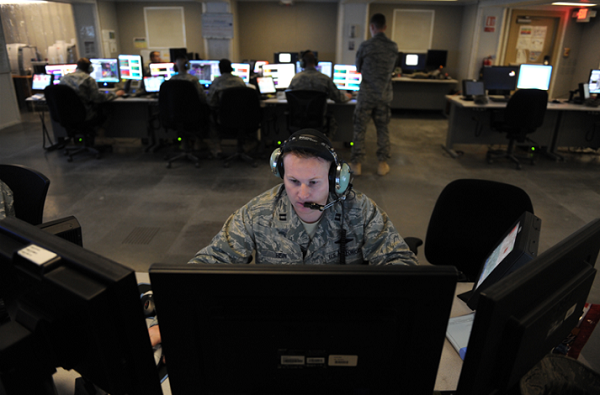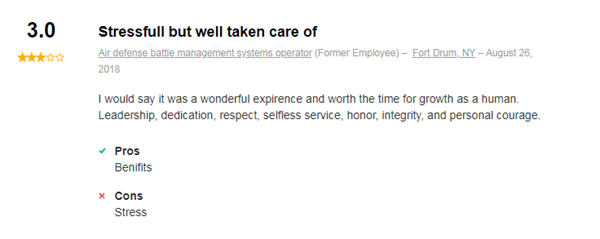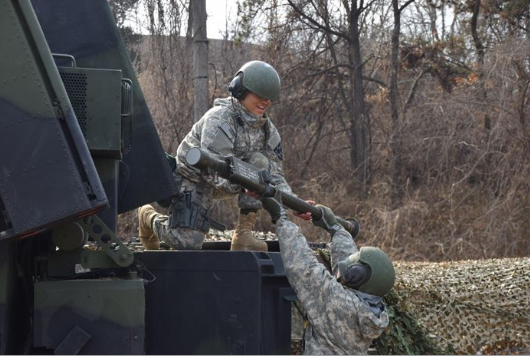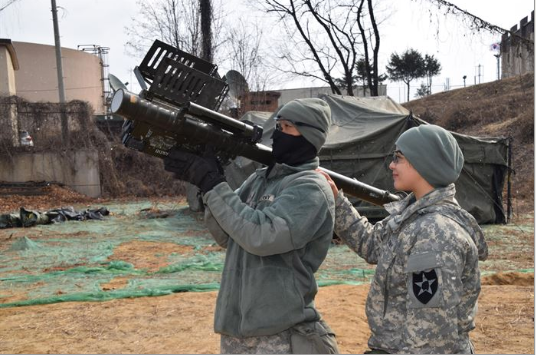Army Air Defense Battle Management System Operators, or MOS 14G, are responsible for maintaining, managing, and operating advanced Military computers.
These complicated systems are on networks, communication equipment systems, and Sentinel Radar.
The systems allow armed forces to have protection from any possible aerial or missile attacks and aerial surveillance.
Qualifications,Training and Duty Stations
Like all other Army jobs, to enter into this position individuals must take the ASVAB test.
Individuals will be required to get a General Technical ASVAB score of 98 and a Mechanical Maintenance score of 96.
After taking and passing the ASVAB test, along with all other medical and fitness tests, job training will consist of Basic Combat Training and Advanced Individual Training.
Basic Combat Training will be 10 weeks long.
Advanced Individual Training will be 16 weeks and 3 days.
Some skills that are helpful in this position include:
- Ability to multi-task, remain calm, adapt and work as a team member
- Interest in work related to accuracy or attention to detail
- Interest in computer systems
Related Article: Which Branch Of The Military Should I Join? 7 Things To Consider
What Does an Army Air Defense Battle Management System Operator Do?

Army Air Defense Battle Management System Operators are the warning, detection, and protection for the armed forces.
These individuals ensure that all air defense detection assets and firing units are integrated.
They are responsible for maintaining computer data that allows for situational awareness and communication of possible threats.
Operating and maintaining Sentinel Radar systems, associated shelters, and electronic and mechanical components is a task for MOS 14G.
They will be required to move, place, operate, and maintain the Sentinel Radar systems in any local or foreign location.
Communication is important, and these specialists are required to establish networks and communications with Allied, Joint, and other Air Defense units.
These specialists will coordinate and establish connectivity in Air Defense Local and Wide Area Networks (LAN/WAN).
Both digital data and voice communications equipment are used.
Multiple Army and Joint-service automated systems will display information regarding battlefield information.
The specialist will be required to collect, distinguish, and process this information.
Evaluating this data and other intelligence data will allow the users to identify targets, provide real-time status reporting during combat and provide early detection.
Early detection could stop and destroy any incoming rocket, mortar, or artillery.
Air Defense Battle Management System Operators clear airspace in order to ensure air superiority and situational awareness.
They will conduct current and future operations planning, along with airspace management requirements.
These specialists will apply the Air Defense Artillery tactics, procedures techniques, and strategy learned in training.
Individuals will be required to work with Air Defense Airspace Management (ADAM) Cell Operations, providing basic maintenance, use, and functional testing of the system.
Air defense formation assignments can include Army Air and Missile Defense Commands, Air Defense Artillery Brigades, maneuver battalions, and sentinel sections.
Possible duty locations could include bases in Korea, Germany, Italy, Alaska, Hawaii, Washington State, Texas, North Carolina, Kansas, Georgia, Colorado, New York, Oklahoma, Louisiana, Kentucky or South Carolina.
Related Article – Cyberspace Operations Officer: Pay, Training, And More
Duty Stations
Those serving in the Army as an MOS 14G can expect to be potentially based at one of the following duty stations:
Inside the Continental US (CONUS)
- Ft. Aberdeen, MD
- Ft. Benning, GA
- Ft. Bliss, TX
- Ft. Bragg, NC
- Ft. Campbell, KY
- Ft. Carson, CO
- Ft. Drum, NY
- Ft. Hood, TX
- Ft. Hunter, CA
- Ft. Irwin, CA
- Ft. Leonard Wood, MO
- Ft. Lewis, WA
- Ft. Polk, LA
- Ft. Riley, KS
- Ft. Sill, OK
- Ft. Stewart, GA
Outside the Continental US (OCONUS)
- Ft. Richardson, AK
- Ft. Wainwright, AK
- Rhine, Germany
- Katterbach Germany
- Vilseck Germany
- Hickam, HI
- Schofield, HI
- Vicenza,Italy
- Casey, South Korea
- Humphreys, South Korea
- Osan, South Korea
- Red Cloud, South Korea
- Yongsan, South Korea
- Arifjan, Kuwait
What is the Pay Like for MOS 14G?
In an entry-level enlisted position such as the MOS 14G, individuals will be paid generally as a Private (E1).
Private (E1) will be paid around $20,000 annually.
This pay can differ the first few months of service.
There are opportunities for Army personnel to receive bonuses for various recruiting opportunities and special positions.
You can view the Army rank and pay table below.
| Insignia | Pay Grade | Rank | Abbreviation | Minimum Monthly Pay |
|---|---|---|---|---|
| E-1 +4 months | Private | PVT | $1,917.60 | |
| E-2 | Private Second Class | PV2 | $2,149.20 | |
| E-3 | Private First Class | PFC | $2,259.90 | |
| E-4 | Specialist | SPC | $2,503.50 | |
| E-4 | Corporal | CPL | $2,503.50 | |
| E-5 | Sergeant | SGT | $2,730.30 | |
| E-6 | Staff Sergeant | SSG | $2,980.50 | |
| E-7 | Sergeant First Class | SFC | $3,445.80 | |
| E-8 | Master Sergeant | MSG | $4,957.20 | |
| E-8 | First Sergeant | 1SG | $4,957.20 | |
| E-9 | Sergeant Major | SGM | $6,055.50 | |
| E-9 | Command Sergeant Major | CSM | $6,055.50 | |
| E-9 | Sergeant Major of the Army | SMA | $6,055.50 |
Benefits
In addition to the pay above, the Army gives benefits that include allowances for certain items.
When living on an Army post, military housing and meals are free.
When an individual is required to live off post, the Army provides food and housing allowances that can vary based on location, rank and family status.
The Army will also provide enlisted soldiers with an annual Army clothing allowance.
Other special situation allowances include cost of living, moving, and family separation allowances.
The Army provides medical and dental at little to no cost, paid sick time, low-cost life insurance, and educational assistance programs.
They also have 30 days of paid vacation a year.
Job Reviews
This is a position that is very demanding.
Individuals note long hours and time away from the family as negative aspects.
Previous employees really like the camaraderie that is built and the discipline they learn.
They note Army benefits and opportunities to advance as positive aspects.
Most reviews indicate the same schedule: morning workouts daily followed by assistance in whatever area you are assigned.
You can see a few Air Defense Battle Management Systems Operator reviews below.


Civilian Career Opportunities
It is hard to find a job that is comparable to an Air Defense Battle Management System Operator.
The skills that are learned with maintenance and communication can relate to a position as an electrician.
Related positions in communications working with LAN/WAN systems are also an option.
The Army currently offers a program called Partnership for Youth Success (PAYS) program.
When you sign up for this program prior to enlisting you will guarantee a job interview at the military friendly employers that have partnered with the program.
While the jobs may not be comparable to the exact position you held, it does give an opportunity for employment.
Related Article – Air Force Aviation Resource Management (1C0X2): Career Profile
Summary

This active duty, entry-level, enlisted position is required to operate computer systems in order to provide warning and detection to armed forces.
Individuals in this position communicate with other groups, monitor air traffic and provide real-time combat status reports.
This Army position allots for basic pay, allowances, and benefits.
People who have held this position previously note that it is fast-paced and has potential long hours, but has great advancement opportunities and provides skill learning.
You can use the skills learned in this position to work in electronics or communication.
References
- Ikon Pass Military Discount: Learn How To Save Big - January 31, 2025
- RTIC Military Discount: Find Out How To Save Big on Gear - January 30, 2025
- Traeger Military Discount: Learn How To Save Big on Smokers - January 28, 2025
General FAQ
What is an Army MOS 14G?
Army Battle Management System Operators (MOS 14G) operate, maintain, and manage military computers for the purpose of detecting and defending against aerial attacks.
What ASVAB score do I need to be an Army 14G?
To become an Army Air Defense Battle Management System Operator (MOS 14G), you’ll need to score 98 on General Technical, and 96 on Mechanical Maintenance when you Armed Services Vocational Aptitude Battery (ASVAB).
Where do Army MOS 14Gs get stationed?
In the U.S., you may be stationed in, Alaska, Hawaii, Washington State, Texas, North Carolina, Kansas, Georgia, Colorado, New York, Oklahoma, Louisiana, Kentucky or South Carolina. Overseas, you may go to South Korea, Germany, or Italy
How long is AIT for 14G?
After 10 weeks of Basic Combat Training, Advanced Individual Training (AIT) is another 16 to 17 weeks long.
What is ADA mean in the Army?
ADA stands for Air Defense Artillery, and soldiers in the 14 series MOS specialize in anti-aircraft weapons, like surface to air missiles. They manage networked computers and communications systems and radar to provide detection, warning, and defense from aerial attacks.

